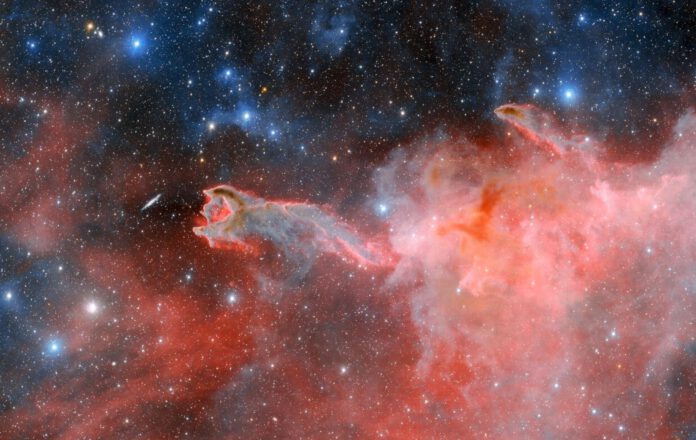
At first glance, it seems that an outstretched hand is reaching out to grab an entire galaxy out of the sky. But appearances can be deceiving; in reality, the galaxy in question is roughly 100 million light-years away, making it decidedly out of reach.
A Spectacular Capture
But let’s not undermine the breath-taking beauty of this image – it’s a superb astronomical photograph crafted by the Dark Energy Camera, located at the Victor M. Blanco 4-meter Telescope in Chile.
Focusing on the Gum Nebula
For this awe-inspiring shot, the camera was pointed towards the Gum Nebula, which is approximately 1,300 light-years from Earth. Nestled within its core is CG 4, an object that strikingly resembles an outstretched, grasping hand.
The Globule Description
Despite its anthropomorphic appearance, CG 4 is, in essence, a cometary globule: a dense cloud of gas and dust that hosts star-forming activities. Remarkably, certain globules, like CG 4, are depleted of a portion of their material, resulting in elongated tails, making them reminiscent of a comet.
CG 4: A Globule with a Tail
CG 4 is a globule with an appendage – its tail measures approximately 8 light-years long, signifying that it would take light 8 years to travel from one end of the tail to the other. At the end of the tail is a somewhat spherical gas and dust cloud about 1.5 light-years wide.
The Gloaming
Despite their captivating appearance, tailed globules like CG 4 are a relatively recent discovery, with astronomers first spotting them in 1976. This belated discovery is attributed to their dense composition of gas and dust that allows almost no light penetration. The reason we can view a stunning capture of a globule is due to a special filter equipped in the Dark Energy Camera, which can detect the faint red glow of ionized hydrogen in the hand and along the arm of CG 4. This glow results from hydrogen bombardment by radiation from nearby hot, massive stars.
The Irony
Interestingly, these nearby stars simultaneously illuminate and erode CG 4 with their intense radiation. However, CG 4 continues to create new stars akin to the size of our sun despite being gradually depleted of gas and dust by these radiant stars.











